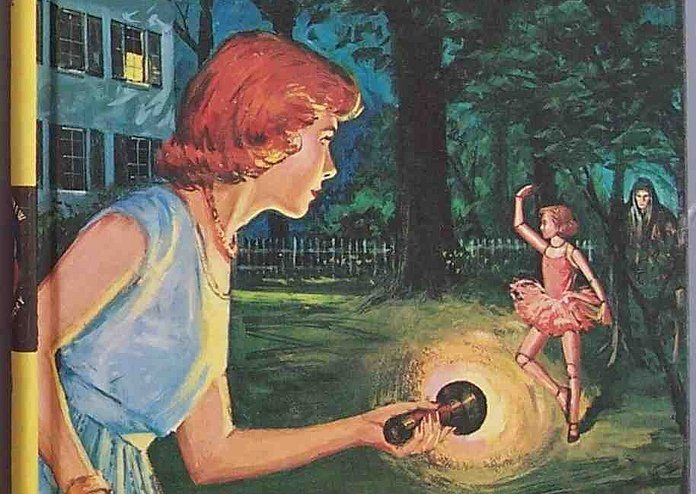“Spend time at the gym to build upper body strength. Detective work may require fending off a vicious hair pulling.” So advises Nancy Drew in The Thirteenth Pearl, foreseeing that state of affairs most particularly dangerous to the female sleuth. Constantly developing accurate ‘hunches’ and pre-empting obstacles, seeing (and solving) crime everywhere, Nancy Drew – the “titian-haired blonde” – has been a paradigm of the female literary detective for over 80 years.
Nancy Drew is as familiar a name as Sherlock Holmes or Hercule Poirot, another character we can chart the proliferations of through contemporary culture. Nancy Drew might be up there amongst the most prolific of all, featuring in over 200 books written by a variety of ghost-writers from 1930 to the present, as well as appearing in films, television series, and video game manifestations. Clearly, Nancy Drew is a formula that sells. Originally conceived as a female counterpart for The Hardy Boys mystery series by the publisher Edward Stratemeyer, distinctive writing style or originality has always been secondary to character, and it is the vision of Nancy herself that has given the franchise unity over the decades.
Taken at a glance, Nancy’s hairpulling quote seems like it could have come straight out of Legally Blonde, films that gloriously reclaim a ‘girlygirl’ image while simultaneously gently satirising it – in particular the socioeconomic background of their heroines. By contrast, Nancy sadly seems to lack the ironising streak that might give her gleaming façade nuance, imperfection, or even a bit of humour.
Nancy can be easily contained in an uncomplicated package of adjectives and nouns, prepared for anything – at once talented sportsman, dignified hostess, and resourceful detective. Her female sidekicks, cousins George and Bess, represent two ends of a spectrum of stereotyped girl, mythically united by Nancy. In The Mystery of the 99 Steps, George the ‘tomboy’ with her “close-cropped, dark hair” is the “exact opposite of her slightly plump cousin”. Dimpled Bess, meanwhile, displays qualities of hesitation and shyness that Nancy is at pains to discourage. In Nancy Drew, everything is done in earnest, everything for a ‘greater good’ that is only vaguely defined.
The ‘mythical’ quality of Nancy Drew is inseparable from her background. Criticism of her impact on popular culture has frequently noted her Wasp status and certainly every appearance of Nancy takes place in a removed, romantic world beyond education or a need to make a living. Many Nancy fans venerate her independence, hard work, and refusal to submit to an authority she does not respect. Certainly there are elements of Nancy’s characterisation, particularly in the earlier titles, that powerfully contradict expectations of women in the social sphere she emerges from. All this coalesces in Nancy’s blue convertible car, the icon of radical female freedom.
Although Nancy does appear in different ways, the formula is essentially unchanging: variations on the same theme, to use a cliché in the vein of the franchise itself. In a world where everyone around Nancy is seemingly one part of her consummate characterisation, Nancy herself is pitted constantly against an ‘other’. In The Mystery at Lilac Inn, Nancy identifies a girl as a thief because she is black and wandering around an upmarket shop. The implicit frame of comparison here is obviously to herself.
For Laura Barton, writing in The Guardian in 2007 upon the release of a new Nancy Drew film, the enduring formula shows that “there is a strength in being unconventional, in being your own kind o’ gal”. Yet Nancy has never really been her own girl. A corporate invention from the beginning – envisioned by a man who later worried that his ghost-writers were giving the articulate Nancy too much ‘flip’ – Nancy Drew became a kind of touchstone for developing styles and tastes, reflected in the book covers for example, as well as becoming markedly more stereotypically feminine.
Nancy is expressive of a highly romanticised, narrowly defined, white American stereotype. As Bobbie Ann Mason puts it, “adventure is the superstructure, domesticity the bedrock”. A voyage into the unknown in the blue convertible will always lead back to the same crystallised vision of carefully tempered, inherently and damagingly qualified ‘achievable’ femininity.



